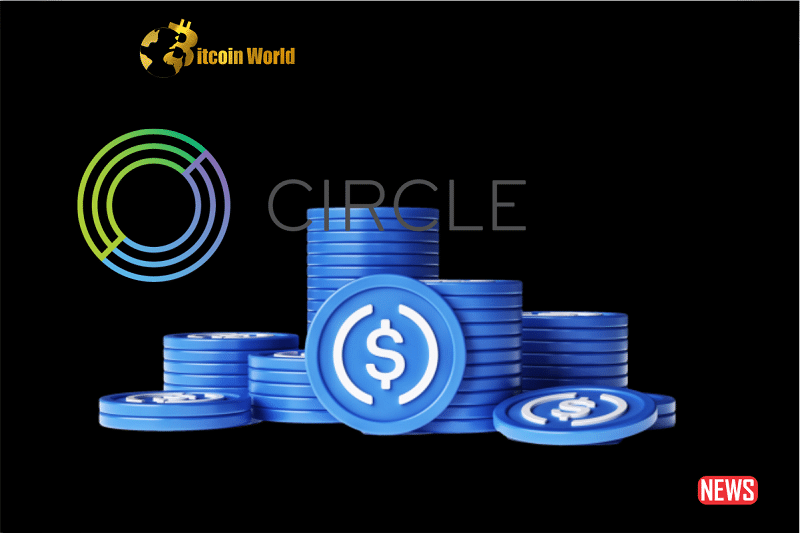Are your stablecoins safe? In the ever-turbulent world of crypto, even the seemingly stable can face unexpected headwinds. Recently, Circle, the issuer of the popular stablecoin USDC, made a significant move to protect its reserves. Why? The looming specter of a potential US debt default.
Why the Reserve Rethink?
Imagine a scenario where the US government can’t pay its bills. Sounds far-fetched? Maybe. But the possibility is real enough for Circle to take proactive measures. Circle’s CEO, Jeremy Allaire, revealed in a Politico newsletter that they’ve strategically adjusted the assets backing USDC. The goal? To minimize exposure to the potential fallout of a US debt default.
The core of the change involves shifting USDC’s reserves entirely to short-dated US Treasuries. Think of it as a financial ‘safety first’ approach. As Allaire stated, they’re avoiding Treasuries that mature after early June, directly addressing the immediate debt ceiling concerns. Their priority is clear: protecting USDC holders from potential disruptions.
“We don’t want to carry the risk of a potential breach in the US government’s ability to pay its debts,” Allaire emphasized.
BlackRock’s Role and Current Holdings
Currently, the assets backing USDC are managed by the BlackRock-managed Circle Reserve Fund. Crucially, these assets are now structured to mature no later than May 31st. This short-term focus is a direct response to the ongoing debt ceiling debate.
The Bigger Picture: The US Debt Ceiling Standoff
The situation is unfolding against a backdrop of tense negotiations. Treasury Secretary Janet Yellen has warned of the difficult “decisions” the government will face if Congress doesn’t raise the federal debt ceiling. The stakes are high. President Biden and Republicans are locked in discussions over lifting the $31.4 trillion debt ceiling, and the outcome could have significant ramifications.
A default by the US government? The consequences could be severe, shaking the $24 trillion Treasury market and potentially triggering broader instability in the global financial system.
How Does This Compare to Other Stablecoins?
Circle isn’t the only stablecoin issuer navigating these uncertain times. Tether, the dominant player in the stablecoin space, has also adjusted its strategy. According to their recent quarterly assurance report, a significant portion of Tether’s reserves are in Treasury Bills with an average maturity of less than 90 days. They are also actively “working to reduce its reliance on pure bank deposits as a source of liquidity.” This indicates a broader trend among stablecoin issuers to prioritize the safety and liquidity of their reserves.
USDC vs. Tether: A Shifting Landscape
The stablecoin market is dynamic, and recent data reveals some interesting shifts:
- USDC’s Supply Decline: Over the past year, the supply of USDC has decreased considerably, falling by 46% from its peak of $56 billion in June 2022.
- Market Share Impact: This decline has impacted USDC’s market share, which now stands at 23% with a circulating supply of $30 billion.
- Tether’s Ascendancy: Tether, on the other hand, has seen its market dominance grow, now holding a 62% share with a circulating supply of $82 billion USDT.
In April, Jeremy Allaire attributed USDC’s declining market capitalization to America’s regulatory approach to crypto and the recent banking sector turmoil. These factors, coupled with the debt ceiling concerns, are shaping the strategies of stablecoin issuers.
Key Takeaways: What Does This Mean for You?
- Increased Scrutiny on Reserves: The focus on stablecoin reserves is intensifying. Users are paying closer attention to the assets backing their stablecoins and the strategies issuers are employing to ensure stability.
- Proactive Risk Management: Circle’s move highlights the importance of proactive risk management in the crypto space, especially in the face of macroeconomic uncertainties.
- Potential Market Shifts: The adjustments in reserve strategies and market share between USDC and Tether demonstrate the evolving dynamics of the stablecoin market.
- Understanding Maturity Dates: Pay attention to the maturity dates of the assets backing stablecoins, particularly during periods of economic uncertainty.
Looking Ahead: The Future of Stablecoins and Economic Stability
Circle’s decision to prioritize short-dated Treasuries underscores the interconnectedness of the crypto market and traditional finance. The ongoing debate surrounding the US debt ceiling serves as a stark reminder of the potential impact of macroeconomic events on digital assets. Stablecoin issuers are adapting, and users are becoming more informed. As the situation unfolds, it will be crucial to monitor how these developments shape the future of stablecoins and their role in the broader financial landscape.
Disclaimer: The information provided is not trading advice, Bitcoinworld.co.in holds no liability for any investments made based on the information provided on this page. We strongly recommend independent research and/or consultation with a qualified professional before making any investment decisions.


